Search
Search
Evaluating the socio-economic benefits of peatland restoration
User Guide for practitioners interested in evaluating the socio-economic benefits of peatland restoration.
Peatland biodiversity - butterflies & moths
Healthy functioning peatlands are vital for biodiversity. While much of the focus is on the specialised plants found on peat bogs, there are a number of butterflies and moths which are associated…
New report highlights multiple benefits of peatland restoration around the world
A new report published today in Brussels highlights innovative projects from around the globe which are helping restore and conserve our threatened peatlands for the multi-benefits they bring to…
New guidance for wetter farming on peatlands
The IUCN UK Peatland Programme’s latest briefing, ‘Principles for Sustainable Peatland Paludiculture’, sets out to ensure the multiple benefits of peatlands are realised when managing different…
About Peatlands
UK Environment Ministers announce Action for peatlands
UK Government Environment Ministers have issues a statement of intent to conserve peatlands in the UK and British Overseas Territories.
Biodiversity
Day of the Bog: Why are peatlands special and do we need to raise awareness?
Bog day 2020 - celebrating the brilliance of bogs.
Peatland Code
The Peatland Code is a key component of the wider work of the IUCN UK Peatland Programme (IUCN UK PP), which has been promoting the restoration and sustainable management of UK peatlands since 2009. Through strong science, sound policy, effective practice, and collaborative partnerships, the Programme advocates for the many benefits peatlands offer from biodiversity and water quality to climate resilience.
FIRNS Project: Biodiversity crediting for Peatlands and Woodlands
Global Peatlands Initiative project: State of the Worlds Peatlands
Global Peatlands Initiative (GPI) launches its Global Peatlands Assessment - The State of the World’s Peatlands - at the United Nations Framework Convention on Climate Change (COP27) taking place…
